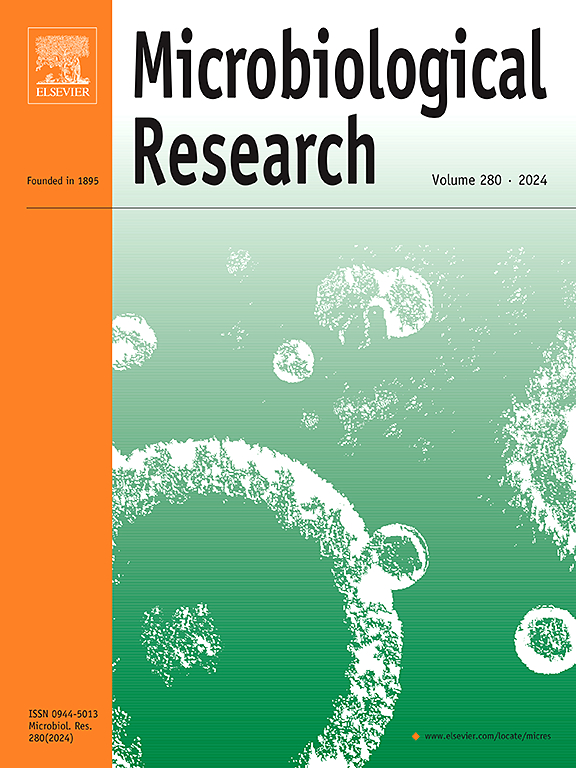Clarification of the biosynthetic gene cluster involved in the antifungal prodrug echinocandin B and its robust production in engineered Aspergillus pachycristatus
IF 6.1
1区 生物学
Q1 MICROBIOLOGY
引用次数: 0
Abstract
Echinocandin antifungals exhibit high efficacy against drug-resistant strains due to their unique mechanism of action. The production of their semi-synthetic precursors relies solely on microbial metabolism, leading to elevated production costs. Anidulafungin, an excellent echinocandin drug, is derived from echinocandin B (ECB), which is industrially produced by Aspergillus pachycristatus. However, the genes involved in the actual ECB biosynthesis remain unclear, which hinders yield improvements through engineered strains. This study systematically investigated the putative ECB biosynthetic gene cluster using genomic and transcriptomic profiling combined with gene editing. Among the 18 putative genes previously reported, only a 13-gene cluster (ecdA, ecdG-J, htyA-F) was found to be actively involved in ECB biosynthesis, while the remaining 5 genes (ecdB-F) were non-essential and functioned independently. Notably, we identified that htyC and htyD were involved in L-homotyrosine biosynthesis, while HtyF catalyzed the C4 hydroxylation of 3S-hydroxyl-L-homotyrosine. Most importantly, EcdJ was identified as a crucial global transcriptional activator regulating the ECB gene cluster. Deletion of ecdJ silenced all related genes and abolished ECB production. Accordingly, overexpressing ecdJ alone or combining ecdA and htyF together significantly enhanced ECB yield. Under optimized liquid fermentation conditions, ECB production in the OEecdJ strain achieved 841 ± 23.11 mg/L. Solid-state fermentation further enhanced the ECB yield to 1.5 g/L, which is 7.7-fold higher than that of the wild-type strain under initial liquid fermentation conditions. This study has thoroughly elucidated the functions of key genes involved in the ECB biosynthesis and provided effective strategies for enhancing antifungal prodrug-ECB production, achieving the highest ECB production in an engineering A. pachycristatus strain.
澄清抗真菌前药棘白菌素B的生物合成基因簇及其在工程肿青曲霉中的稳健生产。
棘白菌素抗真菌药因其独特的作用机制而对耐药菌株表现出较高的疗效。其半合成前体的生产完全依赖于微生物代谢,导致生产成本上升。Anidulafungin是由肿青曲霉(Aspergillus pachycristatus)工业生产的棘白素B (echinocandin B, ECB)衍生而来的一种优良的棘白素药物。然而,参与实际ECB生物合成的基因仍不清楚,这阻碍了通过工程菌株提高产量。本研究利用基因组和转录组学分析结合基因编辑系统地研究了假定的ECB生物合成基因簇。在先前报道的18个推测基因中,只有13个基因簇(ecdA, ecdG-J, htyA-F)被发现积极参与ECB的生物合成,其余5个基因(ecdB-F)是非必需的且独立起作用。值得注意的是,我们发现htyC和htyD参与了l-同型酪氨酸的生物合成,而HtyF催化了3s -羟基- l-同型酪氨酸的C4羟基化。最重要的是,EcdJ被确定为调控ECB基因簇的关键全球转录激活因子。ecdJ的缺失使所有相关基因沉默,并消除了ECB的产生。因此,单独过表达ecdJ或将ecdA和htyF组合在一起显著提高了ECB收益率。在优化的液体发酵条件下,OEecdJ菌株的ECB产量为841 ± 23.11 mg/L。固态发酵进一步提高了ECB产率,达到1.5 g/L,比初始液体发酵条件下野生型菌株的产率提高了7.7倍。本研究彻底阐明了参与ECB生物合成的关键基因的功能,并为提高抗真菌前药ECB的产量提供了有效的策略,实现了工程A. pachycristatus菌株ECB的最高产量。
本文章由计算机程序翻译,如有差异,请以英文原文为准。
求助全文
约1分钟内获得全文
求助全文
来源期刊

Microbiological research
生物-微生物学
CiteScore
10.90
自引率
6.00%
发文量
249
审稿时长
29 days
期刊介绍:
Microbiological Research is devoted to publishing reports on prokaryotic and eukaryotic microorganisms such as yeasts, fungi, bacteria, archaea, and protozoa. Research on interactions between pathogenic microorganisms and their environment or hosts are also covered.
 求助内容:
求助内容: 应助结果提醒方式:
应助结果提醒方式:


